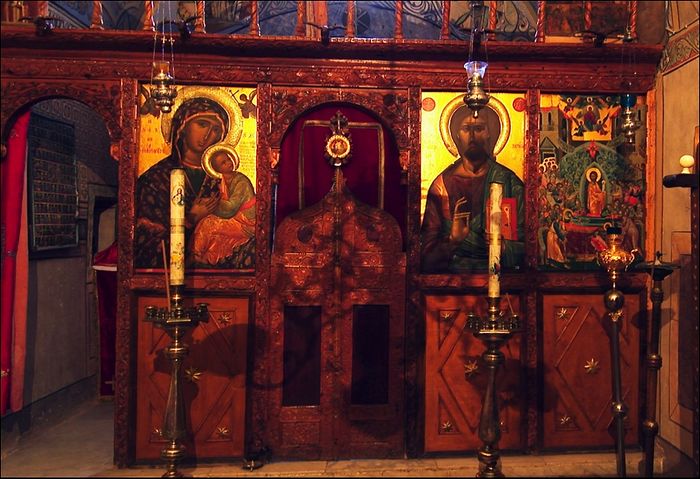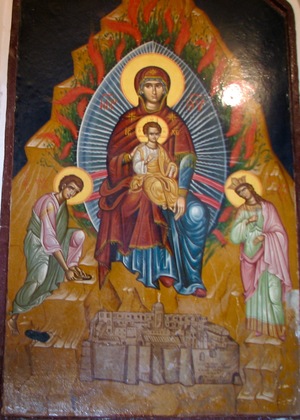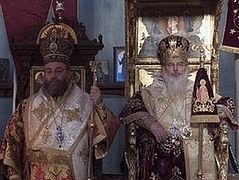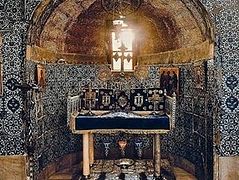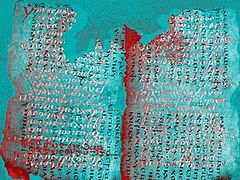Source: Friends of Mount Sinai Monastery
August 15, 2016
Rejoice, fiery throne of the Lord God;
Rejoice, the sacred vessel that is filled with
manna.
Like families anywhere, monastic communities have their public and private challenges, and turn their best face to the world. Unstudied contentment reasserts its hold over the Sinai fortress each year however, as monastics converge on the Monastery from all directions, drawn back for the celebrations of the Dormition of the Theotokos from near or far flung hermitages throughout the Mediterranean world.
At the Cairo branch monastery that serves as transit hub for the desert, quietly reflecting on the buoyant air of anticipation, an old-time monk spoke for all, “Panagia gathers us in to her Feast.”
And in Athens, the courtyard of St. Catherine’s branch church fills on the holy day with all manner of self-proclaimed non-believers, atheists, and many of the afflicted who otherwise confine themselves to society’s peripheries.
Everyone knows where home is on the great Feast day of the Mother of God.
Well into his sixth decade of travelling by night and working by day in service to God and man, the Archbishop and Abbot of the Monastery may arrive last of all, just in time to enter Justinian’s great basilica for the start of the agrypnia, the all-night Liturgy in honor of the Feast. In more peaceful times, the church would be crowded with pilgrims, many of whom returned year after year. Most however reached Sinai after attending the Feast day services in Jerusalem at the empty tomb of the Theotokos in Gethsemane.
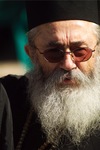
Much has been made of the Sinai Monastery’s preservation of the precious artifacts of ancient Christianity, and also of the unbroken ages of its peaceful co-existence with neighbors in a non-Christian world.
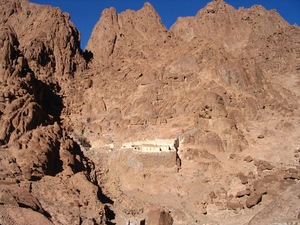 Sinai’s 3rd century women’s hermitage of Saint Epistimi
Sinai’s 3rd century women’s hermitage of Saint Epistimi
Naturally isolated by remote desert, ascetics seeking stillness never needed to fabricate a barrier to worldly civilization by sealing the Monastery off from visits by families. Of course such a step would never have been contemplated by the guardians of a holy pilgrimage of such literally Biblical proportions. By the time the world resolutely landed on their doorstep with the construction of asphalt roads and tourist infrastructure, Sinai monks had long accustomed themselves to a double burden: combining the rigors of eremitic life with hospitality to those seeking deeper understanding of God.
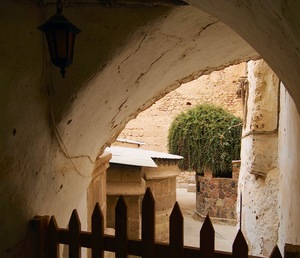 The Burning Bush grows until today outside the chapel built by Saint Helena in the 4th century.
The Burning Bush grows until today outside the chapel built by Saint Helena in the 4th century.
Let us ever applaud and praise the Lord God
Who was seen of old on the holy mount in glory,
Who by the fiery bush revealed the great mystery of
the
Ever-virgin and undefiled Maiden unto the Prophet
Moses.
Aflame but not consumed by the fire of divinity just like the Bush itself, the Holy Virgin is the fiery pillar guiding the faithful through the darkness of this world’s trials. The Israelites were led through the Sinai by fire at night and a cloud by day, and the Holy Virgin spreads the protection of her shelter over the world more broadly than a cloud. Under it, her love gathers together not only the monastics of Sinai, but all the faithful who glorify her Son, the God-man who saves the world from sin as He saved His All-holy Mother from the corruption of death at her Dormition.
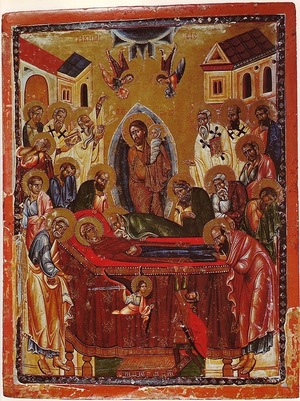 Sinai icon of the Dormition of the Theotokos from the latter half of the 13th century.
Sinai icon of the Dormition of the Theotokos from the latter half of the 13th century.
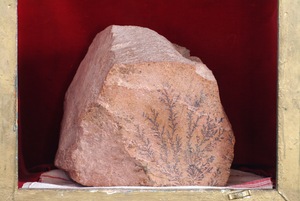 Rocks are found on Sinai bearing the image of the Burning Bush.
Rocks are found on Sinai bearing the image of the Burning Bush.
The first chapel at Mount Sinai was built to the Mother of God by Saint Helena in the 4th century, its Holy of Holies placed directly over the roots of the Bush which still grows just outside. The chapel commemorates the Annunciation of the Theotokos, the living “Ark of the Covenant” who contained the uncontainable Word of God within her womb.
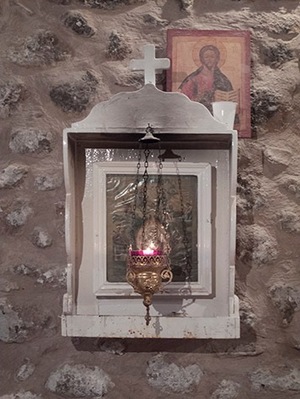 A lamp is kept lit in the Monastery bakery before an icon of the Virgin Mary of the Burning Bush.
A lamp is kept lit in the Monastery bakery before an icon of the Virgin Mary of the Burning Bush.
A lower floor of the same tower contains a much smaller chapel of Panagia. This was but a humble storeroom when the monks ran out of olive oil. Pressed into service, the famed anchorite George of Arselao was asked to pray over
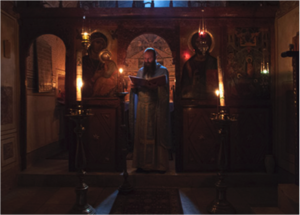 Sinai monks liturgize at the Dormition of the Theotokos in the chapel dedicated to the Feast, located in the 4th century tower built by Saint Helena.
Sinai monks liturgize at the Dormition of the Theotokos in the chapel dedicated to the Feast, located in the 4th century tower built by Saint Helena.
Outside the Monastery enclosure there are more chapels honoring Panagia. An historic one marks the spot on the Holy Mountain where the Theotokos appeared to the monks. The fathers were about to leave the Monastery in desperation after running out of food. Ascending to the Holy Summit of Sinai one last time to pray, their Protectress met them on the path dressed as a local woman, and sent them back to find a caravan at the Monastery entrance unloading abundant supplies. The mysterious benefactors were described as a “princess and her trustee” now vanished, who the monks realized were the Holy Virgin and Moses.
The ascetic literature also records a vision in which Sinai hermit John the Sabbaite found himself on Golgotha, being reproved by the crucified Saviour for having condemned another by exclaiming “Ouph!” upon hearing of his failing. Standing in the same spot and turning to his right, John would have encountered a wall fresco of the Panagia of the Burning Bush, reminding pilgrims of the indelible connection between Jerusalem and Sinai in the person of the Theotokos – the bridge from Old to New Testaments, from earth to heaven, ignorance to knowledge, from the threat of death, to the Source of life.
Containing the stone tablets with the Ten Commandments, the gold-plated Ark of the Covenant was carried by the children of Israel from Sinai to God’s dwelling place in Jerusalem, according to the instructions given to Moses on the Holy Mountain.
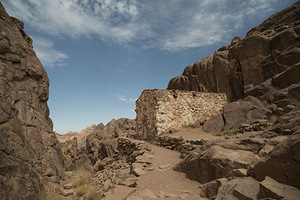 Panagia Oikonomissa (Stewardess) marks the spot where the Theotokos appeared to the monks on Mount Sinai.
Panagia Oikonomissa (Stewardess) marks the spot where the Theotokos appeared to the monks on Mount Sinai.
The reverberations of the great bell of the Church of the Holy Sepulchre toll as if from the center of the earth during the commemoration of the Apostles’ procession that bore the body of the Virgin to her tomb in Gethsemane. Now, however, the tomb is empty – for the All-holy one was taken to heaven with her body. The crush of pilgrims following in the procession is so great that one cannot even see the ancient steps underfoot, but no matter; no one can fall for the press of the crowd, supported by the body of Christ in a vivid icon of the salvation bestowed by the Church on the faithful who honor His All-pure Mother.
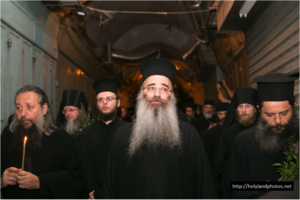
A monk skilled in the obscurities of ancient liturgical practice, understood perfectly perhaps only to himself, lights and snuffs thick candles at appointed times in the services. Held aloft by massive candelabra resting on the backs of brass lions in roguish attitudes, their alternating light and darkness contribute added mystery to the unearthly proceedings.
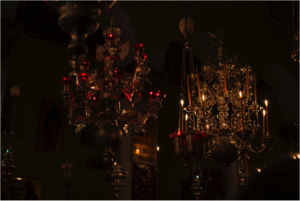
The heavens were astonished and stood in
awe,
and the ends of the earth, Maid, were sore
amazed,
for God appeared bodily to mankind as very
man.
And behold, your womb has proved to be
vaster
and more spacious than heaven's
heights.
For this, O Theotokos, the choirs and
assemblies of men and angels
magnify your name.
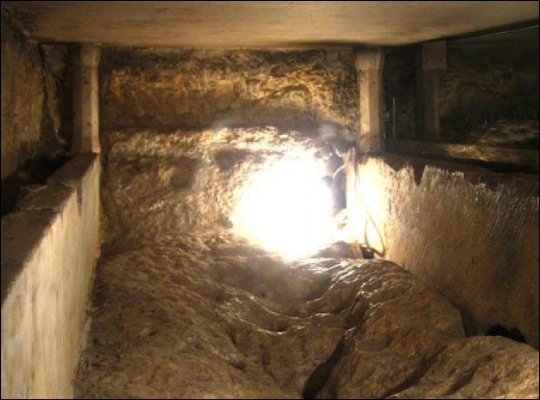 The empty tomb of the Holy Virgin in Jerusalem
The empty tomb of the Holy Virgin in Jerusalem
Quoted texts from the Dormition services’ 13th century Great Supplicatory Canon to the Most Holy Theotokos.
Thanks to Massimo Pizzocaro for the use of his photos.

